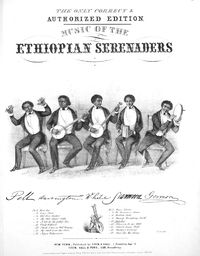Annotation:Old Joe (3): Difference between revisions
No edit summary |
No edit summary |
||
| Line 2: | Line 2: | ||
{{TuneAnnotation | {{TuneAnnotation | ||
|f_tune_annotation_title= https://tunearch.org/wiki/Annotation:Old_Joe_(3) > | |f_tune_annotation_title= https://tunearch.org/wiki/Annotation:Old_Joe_(3) > | ||
|f_annotation= | |f_annotation='''OLD JOE (3).''' American, Air (2/4 time). G Major. Standard tuning (fiddle). One part. "Old Joe" is a comic black-face minstrel love song first published in New York in 1844, set to a simple melody that is little but a syncopated version that of the children's song "Twinkle Little Star." The lyrics to the Ethiopian Serenader's version [http://levysheetmusic.mse.jhu.edu/catalog/levy:020.106], published in 1848 and attributed to T. Halliday, go: | ||
[[File:ethiopian2.jpg|200px|thumb|right|The Ethiopian Serenaders, 1848]] | [[File:ethiopian2.jpg|200px|thumb|right|The Ethiopian Serenaders, 1848]] | ||
<blockquote> | <blockquote> | ||
| Line 36: | Line 35: | ||
''For Death stopp'd de kicking up ob poor old Joe.''<br> | ''For Death stopp'd de kicking up ob poor old Joe.''<br> | ||
</blockquote> | </blockquote> | ||
The song has also been attributed to Frank Bower of the Virginia Minstrels who penned it in 1844. However, the character of the old black man was an early staple of the minstrel genre; in 1845, Joel, Sam, and Dick Sweeney formed the minstrel troupe "Old Joe's Minstrels" (Joel Sweeney [http://en.wikipedia.org/wiki/Joel_Sweeney] is popularly credited, albeit probably erroneously, with adding the 5th string to the banjo). The author of the banjo tutor listed below, Gumbo Chaff, was a pen-name of Boston publisher [[biography:Elias Howe]]. The melody to "Old Joe" was entered in to the mid-19th century music manuscript collection of Bellport, Long Island, ship's captain and fiddler [[biography:Isaac Homan]], along with other blackface minstrel favorites. | The song has also been attributed to Frank Bower of the Virginia Minstrels who penned it in 1844. However, the character of the old black man was an early staple of the minstrel genre; in 1845, Joel, Sam, and Dick Sweeney formed the minstrel troupe "Old Joe's Minstrels" (Joel Sweeney [http://en.wikipedia.org/wiki/Joel_Sweeney] is popularly credited, albeit probably erroneously, with adding the 5th string to the banjo). The author of the banjo tutor listed below, Gumbo Chaff, was a pen-name of Boston publisher [[biography:Elias Howe]]. The melody to "Old Joe" was entered in to the mid-19th century music manuscript collection of Bellport, Long Island, ship's captain and fiddler [[biography:Isaac Homan]], along with other blackface minstrel favorites. | ||
|f_source_for_notated_version= | |||
|f_printed_sources= Gumbo Chaff ('''The Complete Preceptor for the Banjo'''), 1851; p. 16. | |f_printed_sources= Gumbo Chaff ('''The Complete Preceptor for the Banjo'''), 1851; p. 16. | ||
|f_recorded_sources=New World 80338, "The Early Minstrel Show" (1985). | |f_recorded_sources=New World 80338, "The Early Minstrel Show" (1985). | ||
|f_see_also_listing=See/hear the tune played on gourd banjo on youtube.com [https://www.youtube.com/watch?v=2jPf2t9L3NE]<br> | |f_see_also_listing=See/hear the tune played on gourd banjo on youtube.com [https://www.youtube.com/watch?v=2jPf2t9L3NE]<br> | ||
}} | }} | ||
Revision as of 06:23, 7 March 2023
X:1 T:Old Joe [3] M:2/4 L:1/8 R:Air B:Gumbo Chaff - The Complete Preceptor for the Banjo (1851, p. 16) N: A later edition of the earliest known banjo tutor, published in 1848. It was written by N:Elias Howe, whose pseudonym Gumbo Chaff is taken from Thomas Dartmouth Rice's N:1834 blackface character. The 1851 edition was published in Boston by Oliver Ditson. N:In 1850 Howe sold some of his works to Ditson (this one among them) and agreed not N: to publish similar works for ten years. Z:AK/FIddler's Companion K:G g|gg f>f|ee d2|z2 zg|ggff|ee d2|z2 z g|gg f>f|ee d2| z2ze|gg/g/ ff/f/|ee/e/ d2|g2g2|GG/G/ d/d/d/d/|ee/e/ dd/d/| c/c/c/c/ B/B/B/B/|AA G2|GG/G/ d/d/d/d/|ee/e/ dd/d/|c/c/c/c/ B/B/B/B/|AA G2||
OLD JOE (3). American, Air (2/4 time). G Major. Standard tuning (fiddle). One part. "Old Joe" is a comic black-face minstrel love song first published in New York in 1844, set to a simple melody that is little but a syncopated version that of the children's song "Twinkle Little Star." The lyrics to the Ethiopian Serenader's version [1], published in 1848 and attributed to T. Halliday, go:

A man down south I once did know;
His head it was as white as snow;
He went down to de Ball one night,
De fust Gal he saw, she was clear out ob sight.
Chorus:
Ole Joe, ole Joe, a kicking up a hind and a foe,
And a yellow Gal a kicking up a hind ole Joe,
Ole Joe a kicking upa a hind and a foe;
And a yellow Gal a kicking up a hind ole Joe.
To a man at de door he den did say,
O who's dat color'd Gal I pray;
Ob de Balldis night she is de Wenus,
Dey call her Roas Clementenus.
Old Joe he walk wid her aside,
And said ole Gal will you be my bride;
She says, dear Joe I must confess,
I really lubs you much de best.
Dey married, but 'tis sad to say,
Dat ole Joe's wife went dead one day;
Dis gib old nigger Joe de blue,
He turn'd round and went dead too.
Last Chorus:
Old Joe, Joe's done kicking up a hind and a foe,
For Death stopp'd de kicking up ob poor old Joe.
The song has also been attributed to Frank Bower of the Virginia Minstrels who penned it in 1844. However, the character of the old black man was an early staple of the minstrel genre; in 1845, Joel, Sam, and Dick Sweeney formed the minstrel troupe "Old Joe's Minstrels" (Joel Sweeney [2] is popularly credited, albeit probably erroneously, with adding the 5th string to the banjo). The author of the banjo tutor listed below, Gumbo Chaff, was a pen-name of Boston publisher biography:Elias Howe. The melody to "Old Joe" was entered in to the mid-19th century music manuscript collection of Bellport, Long Island, ship's captain and fiddler biography:Isaac Homan, along with other blackface minstrel favorites.

